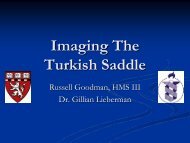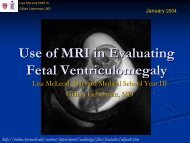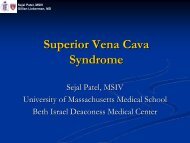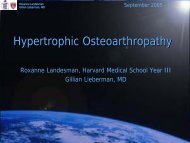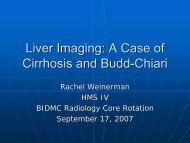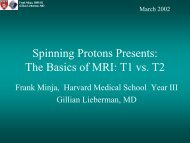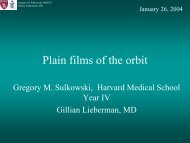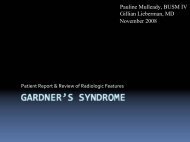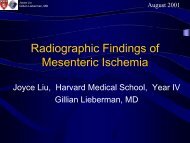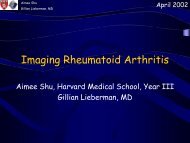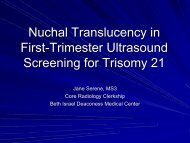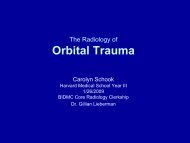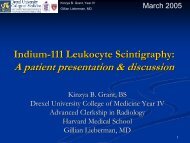Achilles Tendon Rupture
Achilles Tendon Rupture
Achilles Tendon Rupture
Create successful ePaper yourself
Turn your PDF publications into a flip-book with our unique Google optimized e-Paper software.
Rebecca Aspden, HMS III<br />
Gillian Lieberman, MD<br />
<strong>Achilles</strong> <strong>Tendon</strong> <strong>Rupture</strong><br />
Rebecca Aspden, Harvard Medical School Year III<br />
Gillian Lieberman, MD<br />
November 15, 2004<br />
1
Rebecca Aspden, HMS III<br />
Gillian Lieberman, MD<br />
<strong>Achilles</strong> tendon:<br />
•Largest tendon in<br />
body.<br />
•Formed from<br />
conjoined tendons of<br />
gastrocnemius and<br />
soleus muscles.<br />
•Inserts on calcaneus.<br />
•Contributes to<br />
plantar flexion of<br />
foot.<br />
www.medicalmultimediagroup.com<br />
2
Rebecca Aspden, HMS III<br />
Gillian Lieberman, MD<br />
Types of <strong>Achilles</strong> <strong>Tendon</strong><br />
Injury<br />
Peritendinosis (peritendinitis)<br />
– Edema and scarring of paratenon (fatty areolar tissue<br />
around tendon).<br />
– Acute pain and swelling.<br />
– Seen in runners who increase their training or run on<br />
uneven surfaces.<br />
Tendinosis<br />
– Intrasubstance degeneration of tendon itself.<br />
Tears (partial or complete)<br />
– Vulnerable zone of avascularity 2-6 cm above calcaneal<br />
insertion.<br />
3
Rebecca Aspden, HMS III<br />
Gillian Lieberman, MD<br />
Who gets tears?<br />
• Average age 35-40.<br />
• Sports act is often triggering factor.<br />
• “Weekend Warrior”<br />
• In elderly underlying systemic disease or<br />
long-term corticosteroid medication may<br />
contribute.<br />
• Chronic degeneration of tendon (tendinosis)<br />
may be predisposing factor.<br />
4
Rebecca Aspden, HMS III<br />
Gillian Lieberman, MD<br />
Our patient<br />
Mr. S is a 37 year-old man who was playing basketball at<br />
the local YMCA on Saturday afternoon. Even though Mr.<br />
S was a serious athlete in college, in the years since<br />
graduation he only makes it to the gym once a week for a<br />
pick-up game with his buddies from the office.<br />
As he was starting to chase after the ball, Mr. S felt a<br />
sudden pain in his left calf and heard a snap. He thought<br />
he had been shot! He could not walk and immediately<br />
limped to the sideline.<br />
5
Rebecca Aspden, HMS III<br />
Gillian Lieberman, MD<br />
• Look for:<br />
Diagnosis<br />
Diagnosis of <strong>Achilles</strong> <strong>Tendon</strong> rupture can almost<br />
always be made clinically.<br />
– Palpable gap in tendon<br />
– Positive Thompson test<br />
– Difficulty standing on toes<br />
– Tenderness<br />
UpToDate<br />
6
Rebecca Aspden, HMS III<br />
Gillian Lieberman, MD<br />
Imaging Options<br />
Plain films are not very helpful.<br />
In questionable cases ultrasound can provide<br />
definitive diagnosis (particularly good in<br />
differentiating partial from complete rupture).<br />
MRI helpful in planning surgery and in<br />
identifying intratendon abnormalities such as<br />
tears, tendinosis, and retrocalcaneal bursitis.<br />
– Helps surgeon decide whether to approximate tendon<br />
ends or use allograft.<br />
7
Rebecca Aspden, HMS III<br />
Gillian Lieberman, MD<br />
Plain film of torn <strong>Achilles</strong><br />
PACS, BIDMC<br />
8
Rebecca Aspden, HMS III<br />
Gillian Lieberman, MD<br />
Longitudinal sonogram showing<br />
partial-thickness<br />
partial thickness tear<br />
Hartgerink et al.<br />
<strong>Tendon</strong> is markedly thickened and hypoechoic.<br />
9
Rebecca Aspden, HMS III<br />
Gillian Lieberman, MD<br />
Longitudinal sonogram showing<br />
full-thickness<br />
full thickness tear<br />
Hartgerink et al.<br />
This ultrasound shows posterior shadowing (due to sound beam refraction at frayed<br />
tendon ends) and 9 mm of retraction with tendon debris between calipers. Another sign<br />
of tear on ultrasound is fat herniation.<br />
10
Rebecca Aspden, HMS III<br />
Gillian Lieberman, MD<br />
<strong>Tendon</strong>s on MRI<br />
Proton<br />
Density<br />
T2<br />
Normal DARK DARK<br />
Degenerated<br />
(tendinosis)<br />
BRIGHT DARK<br />
Torn BRIGHT BRIGHT<br />
11
Rebecca Aspden, HMS III<br />
Gillian Lieberman, MD<br />
NORMAL - axial<br />
Proton density T2<br />
PACS, BIDMC<br />
<strong>Achilles</strong> tendon<br />
PACS, BIDMC<br />
12
Rebecca Aspden, HMS III<br />
Gillian Lieberman, MD<br />
NORMAL - sagittal<br />
Proton density T2<br />
PACS, BIDMC<br />
<strong>Achilles</strong> tendon<br />
PACS, BIDMC<br />
13
Rebecca Aspden, HMS III<br />
Gillian Lieberman, MD<br />
<strong>Tendon</strong>s on MRI<br />
Proton<br />
Density<br />
T2<br />
Normal DARK DARK<br />
Degenerated<br />
(tendinosis)<br />
BRIGHT DARK<br />
Torn BRIGHT BRIGHT<br />
14
Rebecca Aspden, HMS III<br />
Gillian Lieberman, MD<br />
DEGENERATED - axial<br />
Proton density T2<br />
slightly increased signal<br />
PACS, BIDMC PACS, BIDMC<br />
15
Rebecca Aspden, HMS III<br />
Gillian Lieberman, MD<br />
DEGENERATED - sagittal<br />
Proton density T2<br />
PACS, BIDMC PACS, BIDMC<br />
thickened tendon<br />
16
Rebecca Aspden, HMS III<br />
Gillian Lieberman, MD<br />
<strong>Tendon</strong>s on MRI<br />
Proton<br />
Density<br />
T2<br />
Normal DARK DARK<br />
Degenerated<br />
(tendinosis)<br />
BRIGHT DARK<br />
Torn BRIGHT BRIGHT<br />
17
Rebecca Aspden, HMS III<br />
Gillian Lieberman, MD<br />
TEAR - axial<br />
Proton density T2<br />
tear<br />
PACS, BIDMC PACS, BIDMC<br />
18<br />
intact plantaris tendon
Rebecca Aspden, HMS III<br />
Gillian Lieberman, MD<br />
TEAR - sagittal<br />
Proton density T2<br />
PACS, BIDMC<br />
avulsed piece of bone<br />
PACS, BIDMC<br />
19
Normal<br />
Rebecca Aspden, HMS III<br />
Gillian Lieberman, MD<br />
Summary - sagittal<br />
Degenerated<br />
PACS<br />
PACS, BIDMC<br />
PACS, BIDMC<br />
Torn<br />
Proton Density Images<br />
PACS, BIDMC<br />
20
Normal<br />
Rebecca Aspden, HMS III<br />
Gillian Lieberman, MD<br />
Summary - axial<br />
Degenerated<br />
PACS, BIDMC<br />
PACS, BIDMC<br />
Torn<br />
Proton Density Images<br />
PACS, BIDMC<br />
21
Rebecca Aspden, HMS III<br />
Gillian Lieberman, MD<br />
Treatment for <strong>Achilles</strong> tendon rupture<br />
Surgery followed by early mobilization has<br />
had better results than just immobilizing<br />
tendon with cast for 8 weeks.<br />
Active rehabilitation phase after surgery is 6<br />
months long.<br />
Most patients can return to pre-injury<br />
activity including sports.<br />
22
Rebecca Aspden, HMS III<br />
Gillian Lieberman, MD<br />
•<strong>Achilles</strong> tendon rupture is<br />
often seen in middle-aged<br />
men who exercise<br />
infrequently.<br />
•Diagnosis is usually made<br />
without imaging but US can<br />
be used in questionable<br />
cases.<br />
•MRI is used in surgical<br />
planning.<br />
Conclusion<br />
www.home.zonnet.nl<br />
23
Rebecca Aspden, HMS III<br />
Gillian Lieberman, MD<br />
References<br />
Anderson, J., J.W. Read, and J. Steinweg. Atlas of Imaging in Sports Medicine. Sydney:<br />
McGraw-Hill Australia, 1998.<br />
Andrews, J.R., B. Zarins, and K.E. Wilk, ed. Injuries in Baseball. New York: Lippincott-Raven<br />
Publishers, 1998.<br />
Halpern, B., S.A. Herring, D. Alcheck, and R. Herzog. Imaging in Musculoskeletal and Sports<br />
Medicine. Malden, MA: Blackwell Science, 1997.<br />
Hartgerink. P. et al. Full- versus Partial-Thickness <strong>Achilles</strong> <strong>Tendon</strong> Tears: Sonographic<br />
Accuracy and Characterization in 26 Cases with Surgical Correlation. Radiology 220: 406-412,<br />
2001.<br />
Kerr, Roger. Magnetic Resonance Imaging of the Foot and Ankle. Seminars in Roentgenology<br />
35(3): 306-318, 2000.<br />
Kjaer, M. et al, ed. Textbook of Sports Medicine. Malden, MA: Blackwell Science, 2003.<br />
Moore, K.L. and A.F. Dalley. Clinically Oriented Anatomy. New York: Lippincott Williams &<br />
Wilkins, 1999.<br />
Southmayd, William and Marshall Hoffman. Sports Health. New York: Quick Fox, 1981.<br />
24
Rebecca Aspden, HMS III<br />
Gillian Lieberman, MD<br />
Acknowledgements<br />
Thanks to Larry Barbaras, Gillian Lieberman, Pamela<br />
Lepkowski, Alice Fisher, and Mary Hochman.<br />
Without their encouragement, inspiration, and technical help,<br />
this presentation would not have been possible.<br />
25



